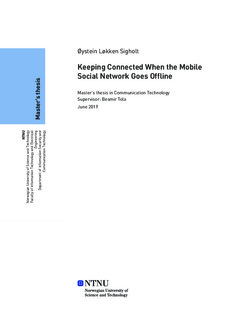| dc.contributor.advisor | Tola, Besmir | |
| dc.contributor.author | Sigholt, Øystein Løkken | |
| dc.date.accessioned | 2019-11-17T15:00:15Z | |
| dc.date.available | 2019-11-17T15:00:15Z | |
| dc.date.issued | 2019 | |
| dc.identifier.uri | http://hdl.handle.net/11250/2628827 | |
| dc.description.abstract | Dette prosjektets mål er å foreslå, implementere og teste en teknikk som sosiale smarttelefonapplikasjoner kan bruke for å koble sammen brukere i situasjoner der de ikke er i stand til å nå applikasjonsserveren, men nær nok hverandre til å støtte peer-til-peer-kommunikasjon.
Den foreslåtte ideen og hovedbidraget fra prosjektet er som følger:
Hver bruker får utstedt et sertifikat fra en sentral autorisasjonsenhet som de kan bruke til å identifisere seg. Hvis en klient ikke er i stand til å nå applikasjonsserveren, vil den begynne å lete etter andre enheter i samme situasjon i nærheten ved å bruke WiFi Direct og forsøke å danne en gruppe med dem. Når en slik gruppe har blitt dannet, vil gruppeeieren midlertidig overta rollen som applikasjonsserver. Hvert gruppemedlem og gruppens eier vil så verifisere hverandres identitet og koble til hverandre ved hjelp av gjensidig Transport Layer Security (mTLS), og dermed muliggjøre sikker kommunikasjon. | |
| dc.description.abstract | The objective of this project is to propose, implement and test a technique that social smartphone applications can use to keep their users connected in situations where they are unable to connect to the application server, but close enough to each other to support device-to-device communication.
The proposed idea and key contribution of this project are as follows:
Each client is issued a certificate by a central authorization entity that they can use to identify themselves at any time. If a client is unable to connect to the application server, it will start looking for nearby peers using WiFi Direct, and attempt to form a group with them. Once a WiFi Direct group is formed, the group owner will temporarily assume the role of application server. Each group member and the group owner will then verify each others identity and connect using mutual Transport Layer Security (mTLS), facilitating secure communication. | |
| dc.language | eng | |
| dc.publisher | NTNU | |
| dc.title | Keeping Connected When the Mobile Social Network Goes Offline | |
| dc.type | Master thesis | |
